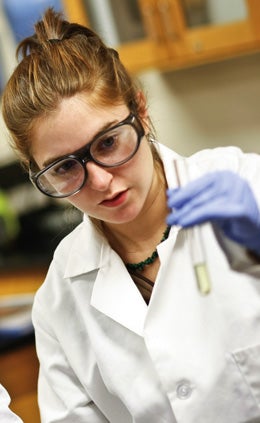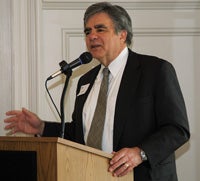A Research Park for URI? Maybe.
 Kansas State University broke ground in November on the Kansas Bioscience Research Park, a $28-million facility meant to support research and commercialization in animal health and food safety.
Kansas State University broke ground in November on the Kansas Bioscience Research Park, a $28-million facility meant to support research and commercialization in animal health and food safety.
A month earlier, Louisiana Tech University broke ground on a technology research park, which state officials hope will create 1,000 jobs in its first decade. In August, New York Mayor Michael R. Bloomberg dedicated a new business incubator in lower Manhattan being run by New York University’s Polytechnic Institute. It is meant to help launch new firms in such signature Gotham industries as fashion, media, and finance.
Definitions vary, but the Association of University Research Parks estimates that there are more than 170 of the facilities in North America, employing more than 300,000. They range from sprawling, multi-university networks like North Carolina’s 50-year-old, 7,000-acre Research Triangle Park, to sites barely the size of a suburban home lot.
The University of Rhode Island “got started relatively late” with plans for a research park of its own, David M. Dooley, the University’s new president, noted in a recent interview. Dooley aims to make sure that when URI gets in the game, it is fully equipped to succeed.
People who haven’t closely followed the evolution of URI’s research park idea may only be aware of the proposal because of a controversy that arose last spring over consultants’ selection of a Flagg Road site, across from the north side of campus, as the best location for the park. A group of URI faculty members protested the selection, saying that putting a park there would conflict with the continued use of a wooded area known as the Century Forest for its 100-year-old trees.
The issue hasn’t been resolved, but in Dooley’s mind the key question isn’t where but when—perhaps even whether.
“The conversation on campus had advanced to a discussion about size, the number of acres, a precise location, but I thought there were some fundamental questions to be answered before we got down to those details,” Dooley said. “When I came here and looked, I noticed that a lot of the analysis that had been done about this was done in a very different economic context and climate. I’m not comfortable that it’s still applicable and accurate.”
Part of the analysis to which Dooley referred was a 128-page report by a Washington, D.C.-area consulting firm evaluating URI’s strengths in terms of faculty research, location, political and “leadership” factors and other criteria; assessing the growth potential of a URI research park based on the performance of four comparable “benchmark” parks around the country; exploring possible financing avenues, and ultimately recommending that the University go forward.
The report was dated August 2007, about when the first serious cracks were appearing in the historic U.S. housing bubble, the collapse of which would lead to the worst financial crisis since the Great Depression. The ensuing recession has been harder on Rhode Island than on almost any other state. The consultants’ report barely mentioned external economic factors; it spoke instead of rising rents and falling vacancy rates for regional office space, reflecting a sunny economic climate that has since gone dark.
Former URI President Robert L. Carothers, though a strong supporter of a research park, decided that it would be unfair for a departing president to green-light so significant a project, since it would be his successor, Dooley, who would have to live with the consequences. Thus, the decision landed in the new president’s lap.

Dooley has opted to go back to the drawing board. He appointed a task force that includes Peter Alfonso, Robert A. Weygand, and Donald H. DeHayes, URI’s vice presidents for research, administration, and academic affairs, respectively. The task force’s charge is to reassess the feasibility of the research park in light of both the changed economic circumstances and the fact that Providence’s jewelry district, renamed the Knowledge District, is trying to attract investment and brainpower in the biosciences. Dooley wants to explore the possibility of URI’s getting involved in that project or in a multi-site solution. He said he was seeking specifics on potential co-investors and sources of revenue as well as a more refined definition of what such a park is meant to achieve and how best to get there. The task force has been asked to report back to Dooley by the end of the fiscal year in June.
Said Dooley: “We want to have a solid enough foundation so that success is, if not assured, then at least likely.”
Alfonso came to URI two years ago from the University of North Dakota, where he had helped launch an ambitious research park. He spoke in an interview about the possible goals of a research park for URI.
Alfonso has estimated that about one-quarter of URI’s faculty works on research with real commercial potential. As things stand now, a URI researcher could create a new technology and license it to a big company in, say, California. A trickle of licensing revenue would flow to the researcher, URI, and the Rhode Island economy, true, but most of the economic benefits in terms of job creation and spin-off businesses would stream to California, where the technology was being developed. A logical next step beyond obtaining licensing revenue from locally-generated technology is for URI researchers to launch their own companies and let their ideas grow up right here—a process that Alfonso said would be facilitated by a research park, as has been amply demonstrated around the country.
The Benefits Go Beyond Opportunities for URI Faculty
“As a state entity, we can’t own a company, but we can take some equity,” which would generate revenue for the University, said Alfonso, who also heads the URI Research Foundation, created by state law in 2007, shortly after he arrived from North Dakota.
Another advantage of a research park is that it can attract existing companies looking for less risky and less expensive means of conducting research and development. Partnering with a university means the company can make its R&D budget go farther because it doesn’t have to create costly facilities of its own—they’re already in place at the university’s biochemistry lab or oceanography institute, for example. It also means access to graduate students as a source of relatively cheap labor in the short term and potential future employees in the long term.
Peter W. Rothberg, a lawyer with Duane Morris LLP in New York who works with venture capital firms, “angel investors” and the fledgling companies they nurture, said that the other side of the same coin is to the benefit of students.
“Given the nature of student bodies these days, they no longer see working for a large corporation as the golden ticket,” he said. “They don’t all want to work for UBS or B of A anymore.”
A research park or business incubator can help the University compete for the highly-motivated students who might be starting companies of their own one day, Rothberg said. It can thereby create a circle of local firms prospering by hiring local students whose experience enables them to seed new local companies that provide opportunities for the next wave of top-notch students.
With 170-plus university-affiliated research parks up and running, is there a danger that URI is too late, that the U.S. is already “over-parked”?
“Are you kidding?” said Rothberg. “There’s a huge surge of entrepreneurialism because you can’t find jobs. If your business needs anything more than a computer terminal, you can’t work at home. You can’t bring clients to Starbucks. Young companies are desperate for help. If you can give them space and all they have to do is move to Kingston, no question they’ll move.”
Edward M. Rudnic ’78, M.S. ’82, Ph.D. ’83, is founder and former chairman and CEO of MiddleBrook Pharmaceuticals, Inc., in Germantown, Md., and a member of the Technology Council of Maryland. He is co-inventor of Adderall XR, a multi-billion-dollar drug used to treat Attention Deficit Hyperactivity Disorder. The Washington Post has described Rudnic as “the face and voice of the region’s biotech industry.”
URI Has the Perfect Location
Rudnic’s three degrees from URI are all in pharmacy. He sounded frustrated in a recent interview that Rhode Island has been slow to embrace the idea of a research park. The economic-development benefits of putting an entrepreneurial enclave in close proximity to an academic center “have been proven in 49 of the 50 states,” Rudnic said.
“North Dakota is ahead of Rhode Island, and there’s something wrong with that,” he went on. “Wyoming is ahead. Iowa has tons of research parks that are thriving.”
Rudnic said that URI’s location in the Northeast Corridor and its proximity to the biotech hub of Boston should be natural advantages for a research park. Another enticement to potential partners would be the just-completed $70-million Center for Biotechnology and Life Sciences. And the Health and Life Sciences complex will soon be enhanced by the new College of Pharmacy, for which a groundbreaking ceremony was held in October.
Research parks can succeed without significant government backing, but the right kind of support can make a huge difference. The University of Maryland Baltimore’s BioPark research complex got a major boost when the state decided to locate its forensic medical lab there.
For graduates who want to pursue the research they did at the university level but in a commercial setting, a research park can encourage them to stick around, Rudnic said. He’s seeing it happen at the UMB BioPark, which he advises.
Lacking similar opportunities at URI, Rudnic said, “most people just move away. You’re talking to one.”
Rudnic said he understood Dooley’s caution about getting the plan right, but all the same, “You can’t break out of an economic slump by not spending money.”
At Montana State University at Bozeman, where Dooley was provost and vice president for academic affairs for eight years before coming to URI, the Center for Entrepreneurship for the New West is trying to help stem persistent brain drain in a place where good-paying jobs are scarce. MSU students have been fully involved, providing 10,000 hours of consulting advice to 40 local companies, since the center opened in 2001, according to Entrepreneur magazine.
Aided by the center, MSU has had great success fostering start-ups, Dooley said, with “dozens and dozens” of little companies launched in engineering and biotech.
“A lot of those companies are not located within the [MSU research] park,” Dooley said, adding that a physical facility is not the sole determinant of a successful academic-commercial partnership.
Success, however URI achieves it, will be defined by hard numbers, including “increases in patent applications, awarded patents, licenses and license revenue, companies created, and the net worth of those companies,” Dooley said.
“The state certainly desires a big success,” he said. “We need desperately to lay the foundation for a new kind of economy in Rhode Island.”
— By Thomas S. Mulligan, M.B.A. ’88
Mulligan, a New York-based executive in the strategic communications firm of Sitrick and Company, is a former senior business and economics writer for the Los Angeles Times.
 Home
Home Browse
Browse Close
Close Events
Events Maps
Maps Email
Email Brightspace
Brightspace eCampus
eCampus


